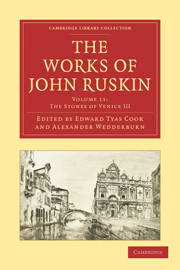AUTHOR'S APPENDIX
Published online by Cambridge University Press: 07 September 2011
Summary
ARCHITECT OF THE DUCAL PALACE
Popular tradition, and a large number of the chroniclers, ascribe the building of the Ducal Palace to that Filippo Calendario who suffered death for his share in the conspiracy of Faliero. He was certainly one of the leading architects of the time, and had for several years the superintendence of the works of the Palace; but it appears, from the documents collected by the Abbé Cadorin, that the first designer of the Palace, the man to whom we owe the adaptation of the Frari traceries to civil architecture, was Pietro Baseggio, who is spoken of expressly as “formerly the Chief Master of our New Palace,” in the decree of 1361, quoted by Cadorin, and who, at his death, left Calendario his executor. Other documents collected by Zanotto, in his work on Venezia e le sue Lagune, show that Calendario was for a long time at sea, under the commands of the Signory, returning to Venice only three or four years before his death; and that therefore the entire management of the works of the Palace, in the most important period, must have been entrusted to Baseggio.
It is quite impossible, however, in the present state of the Palace, to distinguish one architect's work from another in the older parts; and I have not in the text embarrassed the reader by any attempt at close definition of epochs before the great junction of the Piazzetta Façade with the older palace in the fifteenth century. Here, however, it is necessary that I should briefly state the observations I was able to make on the relative dates of the earlier portions.
- Type
- Chapter
- Information
- The Works of John Ruskin , pp. 247 - 308Publisher: Cambridge University PressPrint publication year: 2010First published in: 1904



